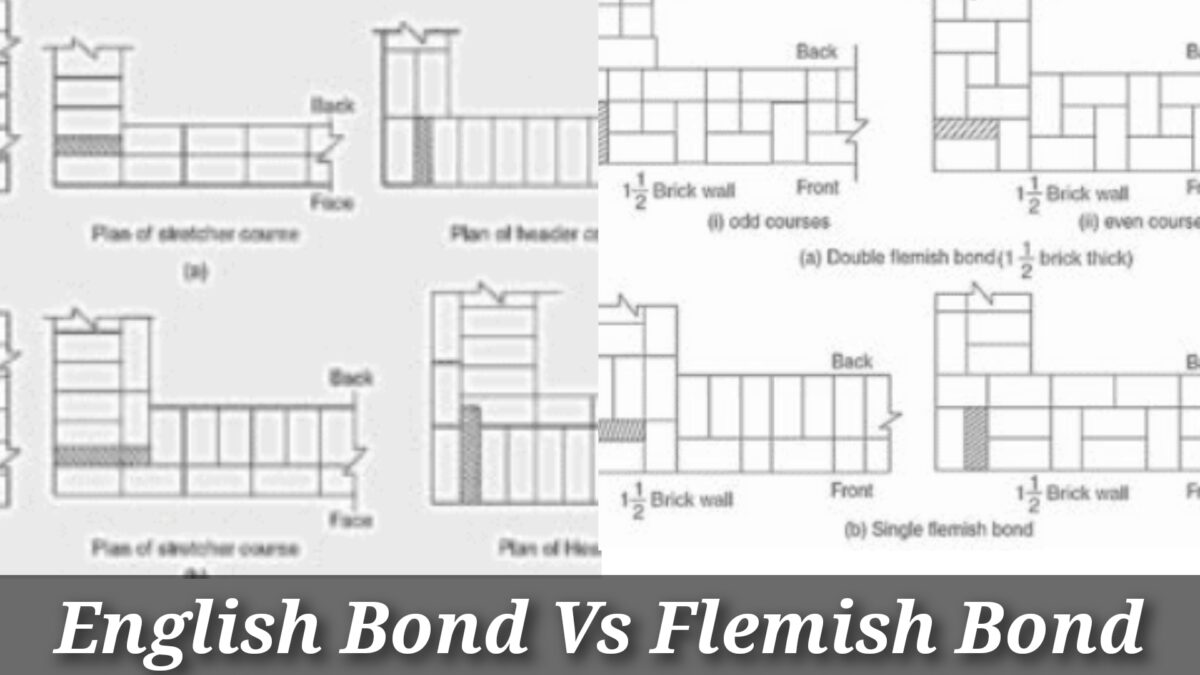
Key Differences between English Bond and Flemish bond are given below:
- English bond is much stronger than a flemish bond for the walls are thicker than 1½ brick.
- Flemish bond shows the more attractive and pleasing visual aspect of masonry work.
- Flemish bond is economical as it utilizes broken brickbats, although it requires some extra mortar for additional joints.
- Uses of the Flemish bond is a bit difficult compared to the English bond. Flemish bond required more skilled labor and supervision.
These were the major differences between the English bond and Flemish bond.
Table of Contents
English Bond:
English bond is considered the strongest and most widely used brick bond in the field of construction. It comprises alternate courses of headers and stretchers. This type of Bond can be constructed for every wall thickness.

In this system, vertical joints in the header and stretcher courses come over each other. To break the vertical joints in the sequential courses queen closer should be placed after the first header in every header course.
Flemish Bond:
In this brick bond, each course comprises alternate headers and stretchers. Every header is peripherally supported over the stretchers below it.

To break the vertical joints in the sequential courses queen closers are placed in alternate courses next to the queen header. Bats are fundamentally required for the walls having their thickness equal to odd numbers of half bricks. The Flemish bond provides a better appearance than the English bond.
There are two types of Flemish bonds as follows.
- Single Flemish bond and
- Double Flemish bond.
English Bond Vs Flemish Bond
In the below table, I have described all the differences between english bond and flemish bond.
| Aspect | English Bond | Flemish Bond |
|---|---|---|
| Pattern | Alternating courses of headers and stretchers | Alternating headers and stretchers in each course |
| Header and Stretcher Placement | Headers placed in alternate courses, stretchers in between | Headers and stretchers alternate in each course |
| Appearance | Emphasizes horizontal lines and creates a grid-like pattern | Emphasizes vertical lines and creates a stacked pattern |
| Bonding Strength | Headers are not well bonded to the wall | Headers overlap, creating a stronger bond |
| Structural Stability | Offers better structural stability | Offers less structural stability |
| Brick Usage | Uses more bricks than Flemish bond | Uses fewer bricks than English bond |
| Wall Thickness | Thinner walls due to the need for a header in every course | Thicker walls due to the overlapping headers and stretchers |
| Laying Difficulty | Easier to lay due to the regularity of the pattern | More challenging to lay due to the irregularity of the pattern |
| Cost | Requires more time, effort, and material | Requires less time, effort, and material |
| Common Use | Commonly used in load-bearing walls and foundations | Used for ornamental work, decorative patterns, and walls |
| Durability | The structure is less durable due to the bond’s weakness | The structure is more durable due to the bond’s strength |
| Moisture Resistance | More prone to water damage due to the weak bond | More resistant to water damage due to the strong bond |
| Fire Resistance | Less fire-resistant due to the bond’s weakness | More fire-resistant due to the bond’s strength |
| Insulation | Offers less insulation due to the thinner walls | Offers better insulation due to the thicker walls |
| Load Capacity | Can carry heavier loads due to the better bonding | Can carry lighter loads due to the weaker bonding |
| Uniformity | Offers a uniform appearance due to the regular pattern | Offers a non-uniform appearance due to the irregular pattern |
| Texture | Offers a smoother texture due to the consistent pattern | Offers a rougher texture due to the irregular pattern |
| Ornamentation | Offers limited opportunity for ornamentation due to the bond | Offers greater opportunity for ornamentation |
| Aesthetics | Offers a classic look, commonly used in traditional designs | Offers a modern look, commonly used in contemporary designs |
These are main differences between english bond and flemish bond. I hope you liked my article.
You can also read other articles!
Thanks for reading!
Keep learning!
